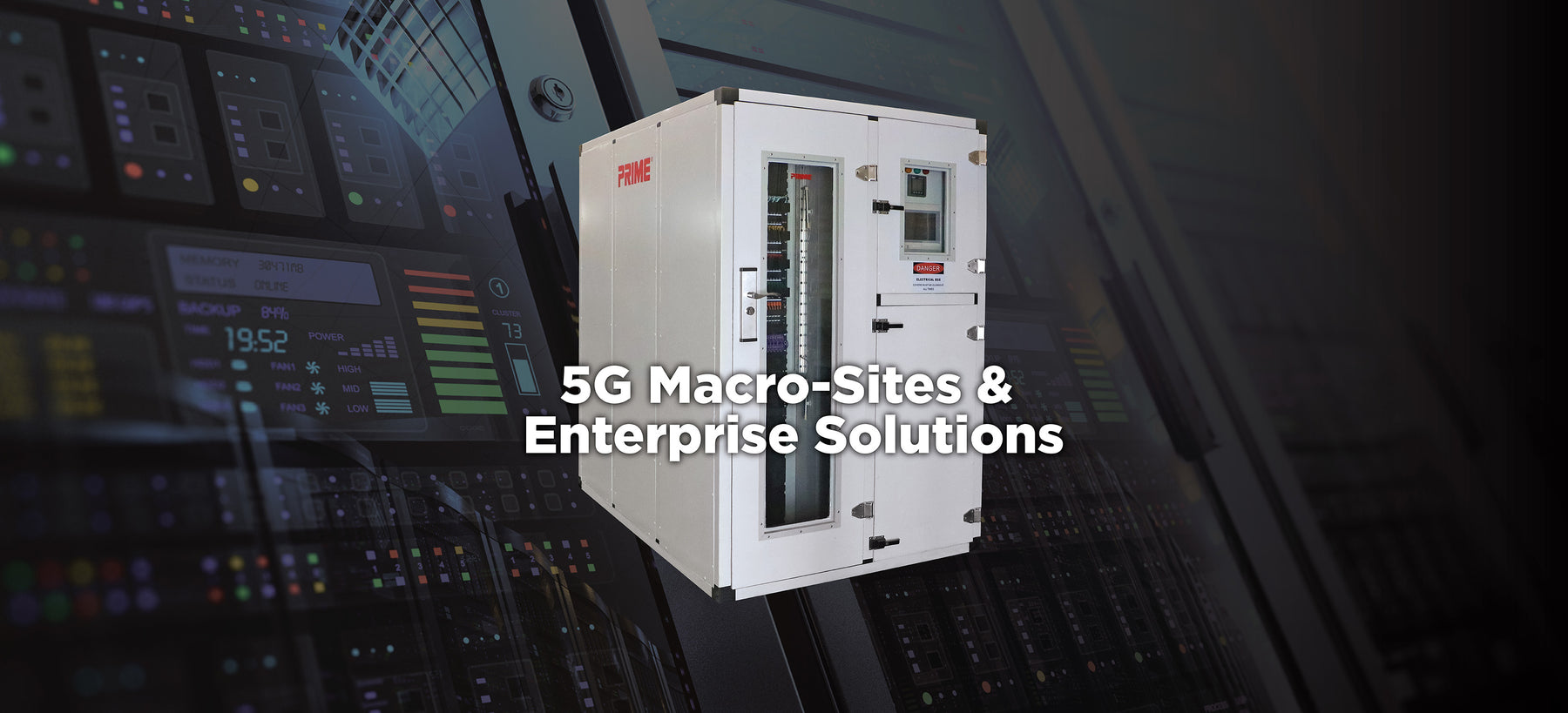
How to Rapidly Deploy and Save Energy in Edge Data Centres
Cloud Computing is gaining tremendous traction in the aftermath of COVID-19. The rise in cloud adoption is resulting in a proportionate increase in data centre computing requirements.
“Cloud Computing” essentially involves data which is stored off-site in massive shared storage facilities and accessed via the Internet. It is scalable (enabling the user to immediately access more data storage space) and maintains redundancies (back-up servers) and security/firewalls to protect the data.
Depending on where the company conducts business, redundant data may be stored in the ‘Cloud’ in multiple data hubs in different regions of a country, as well as globally.
Impact of Edge Computing and Distributed Cloud
In the past, data centres took on average around 2 years to design. Now, deployment times have shrunk down to months instead of years.
This is where Edge Computing comes in. It is one of the prime solutions to tackle latency (buffering, lag or other such transmission delays) caused by the demands of technology such as streaming, AI (Artificial Intelligence), Augmented and Virtual Reality, and the IoT (Internet of Things).
All of this puts exponential demands on the over 800 zettabytes of data processing and storage kept in the Cloud. For enterprise solutions and 5G networks, Edge Computing/Distributed Cloud brings caches of data and processing closer to where it’s being utilised.
It is complimentary to Cloud Computing and dramatically reduces latency for streaming and IoT (smart) devices.
Edge Computing relocates crucial data processing to the ‘edge’ of the network instead of requiring the data to travel between all users of that particular data and a central server. A Distributed Cloud infrastructure and Edge Computing requires Edge Data Centres in order to process and store vital data and application needs in a localized environment.
Further, Edge Computing is ideal for applications where ‘real time’ processing with dramatically reduced latency is required such as: robotic surgeries and medical procedures, automated manufacturing, real-time control of automated vehicles, smart devices, smart homes & buildings, and for most people the basic needs caused by the shift to streaming for telecommunications, social media & entertainment.
Bringing data to the ‘Edge’ reduces traffic volumes and storage requirements at centralised data centres.
Challenges in Edge Computing
A few major challenges for Edge Computing and 5G infrastructures in general are primarily deployment speed, how to roll out tens of thousands of Edge Data Centres instantly, manage costs and be sensitive to the environment, all at the same time.
Prime Modular Data Centers’ line of prefabricated Modular Data Centres (MDC) with Intelligent Natural Air Cooling addresses these needs. Prime Modular Data Centers is a division of Prime Wire & Cable which was founded in 1986 and established its presence in the USA Industrial and Home Improvement market channels with vertically integrated extension cord & electrical accessories design, manufacturing and distribution in Southern California.
For its MDCs, Prime created economies of scale by utilising the same components and a limited amount of structures which enables speed to market in 50- 60 percent less time than traditional Edge solutions for 5G Macro-Sites or Enterprise environments.
By utilizing Natural (free) Air Cooling with Siemens Environmental controls, Prime cut cooling costs by 50 percent over traditional HVAC methods – a vital step considering that cooling data centres draws approximately 50 percent of the power required to run a data centre. Also, their supplemental evaporative cooling method uses 75 percent less water than traditional water-based cooling systems – once again being sensitive to the environment.
Rapid Deployment of Modular Data Centres
Prime’s Modular Data Centres with Natural Air Cooling are the ideal solution for the rapid deployment needs of Distributed Cloud/Edge Computing for 5G Macro-Sites and Enterprise applications, while being sensitive to the urgent need to reduce the ever-growing energy demands of storing and transporting data.
Prime’s MDCs utilize pre-fabricated structural components, and a Siemens Environmental Programmable Logic Control system with approximately 100 different sensors built into each MDC to measure and control temperature, relative humidity, power consumption, security, lighting and more – on site or remotely.
Natural Air Cooling provides a PUE (Power Usage Effectiveness) of less than 1.1 – meeting ASHRAE standards – and because there is no need for traditional HVAC in most locations where these MDCs are deployed, can reduce energy costs by at least 50 percent annually. The Supplemental Evaporative Cooling (which helps to balance the MDCs internal relative humidity) uses 75 percent less water annually than traditional water-based HVAC solutions.
These pre-fabricated solutions allow for rapid deployment and ease of expandability. Prime’s units are a practically ‘plug & play’ solution because Prime can pre-wire each MDC with Prime’s structured cable patch cables, patch panels and accessories prior to deployment, reducing the set-up time at the site to installing the user’s servers, UPS & batteries and then plugging in the MDC to a power outlet. At the site, the primary needs are power, water and a flat surface.
Low TCO
Total Cost of Ownership is lower due to:
- Reduced design time & cost
- Infinitely less construction time/cost
- Faster deployment
- Reduced energy costs because of the simplified cooling system
- Lower maintenance and operating costs
All of which provides a faster return on investment.
Because Prime has already been providing Structured Cabling Solutions for use in traditional data centres and server rooms, as 5G and the Distributed Cloud/Edge computing models started to develop, they saw an opportunity to contribute, hence the development of Prime’s Modular Data Center program.
Prime has 5 basic models for 5G Macro-Sites, Enterprise Solutions and Emergency Services applications:
- 1-Rack (32U) 2kW Indoor Enterprise/Emergency Services Solution
- 1-Rack (32U) 5kW Indoor Enterprise/Emergency Services Solution
- 1-Rack (42U) 15kW Indoor & Outdoor Macro-Site/Enterprise/Emergency Services Solution
- 2-Rack (42U) 15kW Indoor & Outdoor Macro-Site/Enterprise/Emergency Services Solution
- 6-Rack (43U) 12kW Indoor & Outdoor Macro-Site/Enterprise Solution
Prime also has a larger 10-Rack Enterprise Data Center solution and can customize solutions to your specific needs.
The Programmable Logic Control from Siemens Environmental that is a part of every Prime MDC can be accessed remotely through login to a web portal, enabling monitoring and control of the following functions:
- Access – the doors have an electronic key with upgrades to biometric options. The doors can be opened from the PLC touch screen panel on the MDC or remotely from a computer, phone or tablet
- Security – cameras inside and out can be monitored remotely
- Alarms – the environmental control system notifies the user when it’s time to change the filters, so there is no guesswork – reducing on-site time, especially when multiple Macro-Site MDC’s are deployed
- Intelligent PDU’s – the power distribution units included with each MDC have the option to have automated switching and monitoring capabilities which are visible on the PLC touch screen panel or remotely
- Environment – sensors monitor the temperature in the ‘cold and hot aisles’ and automatically turn on/off the high-speed fans that circulate external ‘natural’ air and the air inside the MDC to maintain optimal operating temperatures and relative humidity – automatically deploying moisture when needed to keep components performing at optimal levels. Dampers will automatically open and close to recirculate air, allow the hottest air to escape and bringing in fresh air as needed.
- Power – in addition to monitoring the PUE level, all aspects of power are monitored through the PLC panel so there is visibility on-site and remotely.
Micro or Edge Data Centres
Currently, depending on which statistics you read, powering the Internet uses between 2 and 10 percent of the world’s electricity demands and is growing at a rate of at least 8 percent annually.
According to a China Mobile study, 46 percent of that energy goes toward cooling data centres.
Of the over 800 zettabytes of data consumption in the ‘information super-highway’ comes from the over 21 billion IoT devices currently deployed worldwide. That number is projected to double by 2030!
There have been over 2.2 billion iPhones sold globally in addition to nearly 11 billion other smart phones, not to mention all the tablets in use. By 2030 projections estimate that powering our insatiable demand for instantaneous data could amount to as much as 20 percent (or more) of the world’s total energy consumption!
Tens of thousands of Edge Data Centres (also known as Micro Data Centres) must be deployed for 5G Wireless and Distributed Cloud/Edge Computing for Enterprise environments to function successfully. Traditionally, data centres have been built from scratch, have followed a model of customized solutions for each deployment, utilize traditional HVAC methods for cooling the servers, and take up to 2 years to deploy.
For Enterprise Solutions and the Distributed Cloud/Edge Computing model, Micro Data Centres are the next generation for Edge Data Centres. Whether for a 5G Macro-Site (antenna array) or an Enterprise Solution, a Micro Data Center needs to be deployed rapidly, should utilize more energy efficient/environmentally friendly cooling solutions, have a smaller, higher density, more consistent footprint, and be easily duplicated for scaling when needed.
Vital need for Distributed Cloud/Edge Data Centres
Subscribing to Distributed Cloud and Edge Computing requires Edge Data Centres in order to process and store vital data application needs in a localized environment. Thousands of Distributed Cloud/Edge Data Centres must be deployed, as they are a key component of the 5G/Edge Computing infrastructure.
To successfully create a network that wirelessly connects all devices and interactions with those devices within the network, data will need to be transferred, stored, and processed at rapid speed. This data processing must also be consistent and highly reliable.
5G’s promise of less than 10 milliseconds of latency and speeds of 1GBps (1 gigabyte per second) is completely dependent on localized infrastructure because 5G operates at frequencies from 24-100GHz, which only travel between 500ft and 3000ft (based on data provided by US cellular providers).
For localised Enterprise applications (emergency services, hospitals, factories, smart cities, homes & buildings, transportation and businesses of all kinds), certain data will need to live on a dedicated network away from the congestion caused by a glut of applications and storage in a Cloud environment. To meet all the growing needs of data and the Internet, providers need to carefully consider what their 5G Macro-Sites, Modular Data Centres and Enterprise can provide.
Visit Prime Modular Data Centers website here.
Check out the video below on how to rapidly deploy data centers and simultaneously gain energy savings.
